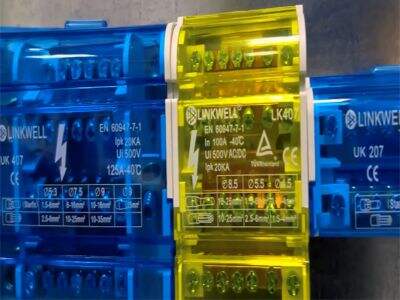Terminal Block Is One Of The Indispensable Parts
In electrical applications, to make connection easily and safely. There are various types of terminal blocks, each having a particular use and benefits. The following types of terminal blocks can give you a better idea about them. Here are six different types of terminal blocks and their applications.
Types of Terminal Blocks Explained
Barrier Terminal Blocks: Barrier terminal blocks are insulated with a plastic or metal barrier between each screw connection point.
DIN Rail Terminal Blocks: The terminal block connects to the DIN rail, and is easy to install and replace on the universal standard DIN rail system. These terminal blocks are a favorite in AC/ DC power applications, and can be found anywhere from the factory floor to most control panels.
PCB Terminal Blocks: Fixed to a printed circuit board (PCB), PCB terminal block connector provide a secure means of connecting the board and external periphery. They are often utilized in electronics and telecommunications applications where space is at a premium.
Pluggable Terminal Blocks: The pluggable terminal blocks are equipped with removable connectors that enables fast and easy installation and servicing time. These terminal blocks are suitable for use in equipment testing or systems requiring communing bars that may need to be added or removed.
Screwless Terminal Blocks Screwless terminal blocks replace traditional screws with spring-loaded clamps to hold wires. The patented design facilitates quick and easy installation without tools, which is critical when jobs need to be done quickly.
Fused Terminal Blocks: Fused blocks integrate a fuse within the terminal block that offers overcurrent protection to linked equipment. These can be used in power distribution systems, motor controls and the like to keep damage from occurring from a fault.
How to Select a Terminal Block for Your Project
When choosing your terminal block, there are a few things to consider:
Voltage and Current Considerations: Based on the voltage and current of your system, choose a terminal block that will not overheat and damage.
Compatibility with wire size: Ensure that the terminal block you select is compatible with the size of wires it will be connecting.
Environmental Factors: Think about the construction and working conditions of your system, like the temperature, humidity and vibration level, so you choose a terminal block that will hold up in those.
Mounting Method: Consider whether you require a terminal block that can be mounted on a DIN rail, PCB or through another method to suit your system requirements.
Other Features: Consider a terminal block with other features like surge protection, LED indication or a disconnection switch to add more functionality and safety to your design.
With knowledge of the different types and considerations it is possible choose the right terminal block for your application, providing a solid and effective electrical connection.
Terminal blocks play a very important role in electric and electronic circuits. They offer a fast, reliable way of making connections and can also help with troubleshooting and repairing circuits. Versatility is one of the key advantages of using terminal block. They are available in different styles and sizes which enables them to be used depending on the requirements of a particular project. Battery terminals also provides for neat and organized wiring, preventing short circuits and helping to ease maintenance tasks. Also, wire terminal block can be reused so that are able to disconnect and re-connect easily without the wire getting cut for applications to test if you need.
What's New in the Industry
Recent years have witnessed great technological advances in terminal block technology. One of the recent developments is modular terminal blocks providing easy add-on and customization of circuits. These modular blocks can be easily linked together to form complex wiring schemes, suitable for project use from concept to completion. Another trend in the market is the introduction of terminal blocks with built-in electronics, including surge protection and signal conditioning.
How to Best Utilize Your Terminal Block Arrangement
To get the most out of your terminal block configuration, it is crucial to consider and arrange your wiring thoughtfully. Begin by tagging all the terminal blocks and wires so that they can be easily identified after troubleshooting. Sharply marked, color coded wires allow you to ease of tracking of the needful circuit and make it easy to know of the wiring connection. It also may be advantageous to utilize terminal blocks that feature push-in or screw less terminations for fast and easy connections. Inspect your terminal blocks periodically and make sure that they are in proper working order; this means swap out any damaged ones and do so without delay. Apply these with and you can easily have a consistent and effective power terminal block for your projects.
Terminal blocks are a great way to connect wiring to electrical or electronic equipment, and easy to install as well. Driven by technology and innovation, the terminal block industry has evolved into a comprehensive offering that provides solutions for various applications.


